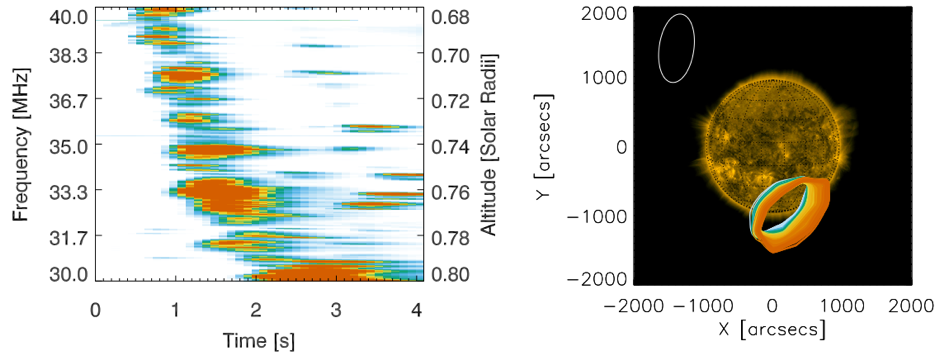The Sun routinely produces energetic electrons in its outer atmosphere that subsequently travel through interplanetary space. These electron beams generate Langmuir waves in the background plasma, producing type III radio bursts that are the brightest radio sources in the sky (Suzuki & Dulk, 1985).
These solar radio bursts also provide a unique opportunity to understand particle acceleration and transport which is important for our prediction of extreme space weather events near the Earth. However, the formation and motion of type III fine frequency structures is a puzzle but is commonly believed to be related to plasma turbulence in the solar corona and solar wind.
Recent work by Reid & Kontar, Nature Astronomy, combines a theoretical framework with kinetic simulations and high-resolution radio type III observations using the Low Frequency Array and quantitatively demonstrates that the fine structures are caused by the moving intense clumps of Langmuir waves in a turbulent medium. These results show how type III fine structure can be used to remotely analyse the intensity and spectrum of compressive density fluctuations, and can infer ambient temperatures in astrophysical plasma, both significantly expanding the current diagnostic potential of solar radio emission.

Image shows dynamic spectra (left) and associated radio contours of solar type III radio bursts observed by LOFAR (right). The LOFAR contours at 75% of the peak flux of the type III bursts going from 40 MHz to 30 MHz in the colour sequence white-blue-green-yellow-red. The LOFAR beam contour at 75% for 30 MHz is shown in the top left corner in white. The background is the Sun in EUV at 171 Angstroms observed by AIA. Image from Reid & Kontar, Nature Astronomy, 2021.
References
Suzuki, S. & Dulk, G. A. Bursts of Type III and Type V 289–332 (Cambridge Univ. Press, 1985)
Reid, H.A.S., Kontar, E.P. Fine structure of type III solar radio bursts from Langmuir wave motion in turbulent plasma. Nat. Astron. (2021). https://doi.org/10.1038/s41550-021-01370-8


